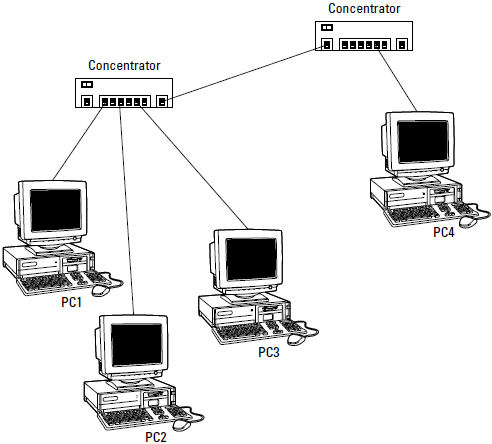Curing Your Network's Growing Pains
You can be almost certain that your home network will grow - you'll add more computers. (Read how to run cable from the new computer to the concentrator in the section, "The Chase Is On: Running the Cable," earlier in this tutorial.) But what happens if you run out of concentrator connections? If you start your home network with a kit built for two computers, where do you plug in additional computers?
You have two solutions:
- Buy a larger concentrator (and sell the original concentrator to a friend who's building a home network).
- Buy another small concentrator and link it to the first concentrator.
You shouldn't need any instructions for carrying out the first solution. The second solution, however, requires a little bit of homework - you need to read the instructions that came with both concentrators to understand how to link them. Every concentrator has an uplink port, which is designed specifically to connect one concentrator to another concentrator, instead of connecting a computer to a concentrator. (Notice that a concentrator that's meant to accommodate four computers has five ports.) Before you use an uplink port, here's what you need to know:
- Where the uplink port is: The uplink port is always at the end of the row of ports (usually next to the place where the power cord goes).
- What the uplink port looks like: Notice that the uplink port is usually marked differently from the other ports, either with an icon (the other ports have no icons) or with the word uplink. (If nothing is visible, check the documentation that came with the hub.)
- What kind of cable you need to hook up two hubs: Sometimes you need to use a crossover cable when you connect two hubs through their uplink ports. You can buy this special cable from the same places that you can purchase regular Ethernet patch cable. Many concentrator manufacturers have a toggle switch to change between regular and crossed cable. Some manufacturers have uplink ports that automatically detect the type of cable and make internal adjustments to make sure that patch cable works the same as a crossover cable. Read the documentation that came with your concentrator.
Run cable from the new computer(s) to the new concentrator and connect the old concentrator to the new one via the uplink port (or the other way around). Read the documentation for both concentrators to see whether you need to use a crossover cable and also to see whether the connection from the uplink port goes into a regular port or into the other uplink port. Figure below illustrates a network with two concentrators.

In this tutorial:
- Installing Ethernet Cable
- Ready, Set, Run
- Ethernet cable has many aliases
- Concerning the concentrator
- Deciding Where to Put the Concentrator
- Concentrators are environmentally fussy
- Concentrators are innately powerless
- Distance Depends on What You Choose to Measure
- Handling Cable Correctly
- Connecting two patch cables
- Making your own patch cables
- The Chase Is On: Running the Cable
- Cabling within a room
- Cabling between adjacent rooms
- Cabling between nonadjacent rooms on the same floor
- Keeping your drill holes in the closet
- Cable that's all walled up
- Cabling between Floors
- Adding cable faceplates
- Using floor cable covers
- Curing Your Network's Growing Pains
- Don't add another router
- Getting into the Zone
